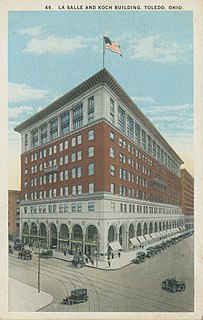Related Research Articles
Marshall Field's was a department store in Chicago, Illinois, founded in the 19th century that grew to become a large chain before being acquired by Macy's, Inc in 2005.

The J. L. Hudson Company was a retail department store chain based in Detroit, Michigan. Hudson's flagship store, on Woodward Avenue in Downtown Detroit, was the tallest department store in the world in 1961, and, at one time, claimed to be the second-largest department store, after Macy's, in the United States, by square footage.

Dayton's was an American department store chain founded in Minneapolis, Minnesota, in 1902 by George Draper Dayton. In 1969, the Detroit-based J.L. Hudson Company merged with the Dayton Company to form the Dayton-Hudson Corporation, adding 21 Michigan-based stores to the total. In 1990, the department-store division of Dayton–Hudson acquired Chicago-based Marshall Field's. Both Dayton's and Hudson's retained their individual store names until 2001, when they were united under the Marshall Field's nameplate. Prior to changing its name to Marshall Field's, Dayton's stores numbered 19, serving communities throughout the upper Midwest.

Dillard's, Inc., is an upscale American department store chain with approximately 282 stores in 29 states and headquartered in Little Rock, Arkansas. Currently, the largest number of stores are located in Texas with 57 and Florida with 42. The company also has stores in 27 more states; however, it is absent from the Northeast, most of the Upper Midwest, the Northwest, and most of California, aside from three stores in smaller cities.
Foley's was a chain of department stores owned by May Department Stores and headquartered in Downtown Houston, Texas. On August 30, 2005, the division was dissolved and operation of the stores was assumed by Federated's Macy's West and Macy's South divisions. Foley's operated stores in Texas, Colorado, Louisiana, Arizona, Oklahoma and New Mexico. On September 9, 2006 Foley's and all the regional May Co. stores names were phased out and rebranded as Macy's.
L. S. Ayres and Company was a department store based in Indianapolis, Indiana, and founded in 1872 by Lyman S. Ayres. Over the years its Indianapolis flagship store, which opened in 1905 and was later enlarged, became known for its women's fashions, the Tea Room, holiday events and displays, and the basement budget store. As urban populations shifted to the suburbs, Ayres established branch stores in new shopping centers in several Indiana cities. Ayres also acquired retail subsidiaries in Springfield, Illinois; Fort Wayne, Indiana; and Louisville, Kentucky. Ayr-Way, the Ayres discount store subsidiary, became the first discount store launched by a full-line department store. By the end of the 1960s Ayres had become a diversified merchandising business with retail department stores, a chain of discount stores, specialty clothing stores, a home furnishings showroom, and a real estate holding company. A long-time Ayres slogan, "That Ayres Look", promoted the company as a fashion leader, and by 1972 it had become the oldest continuous retail slogan in the United States.
The Jones Store Company was an American chain of department stores located in the Kansas City area formerly operated by Mercantile Stores Company and the St. Louis, Missouri-based May Co.

B. Dalton Bookseller was an American retail bookstore chain founded in 1966 by Bruce Dayton, a member of the same family that operated the Dayton's department store chain. B. Dalton expanded to become the largest retailer of hardcover books in the United States, with 798 stores at the peak of the chain's success. Located primarily at indoor shopping malls, B. Dalton competed primarily with Waldenbooks. Barnes & Noble acquired the chain from Dayton's in 1987 and continued to operate it until a late 2009 announcement that the last 50 stores would be liquidated by January 2010.

Associated Dry Goods Corporation (ADG) was a chain of department stores that merged with May Department Stores in 1986. It was founded in 1916 as an association of independent stores called American Dry Goods, based in New York City.
McAlpin's was a Cincinnati-based department store founded in 1852 as Ellis, McAlpin & Co. McAlpin's opened their landmark downtown location on Fourth Street in 1880. In 1954, McAlpin's became the first Cincinnati department store to open a suburban site, in the Western Hills Shopping Center.

The Elder-Beerman Stores Corp. was a chain of department stores founded in 1883 and whose last stores closed in 2018. The chain, based primarily in the Midwestern United States, was composed of 31 stores in eight states at the time of its liquidation in 2018, and peaked around 2003 with 68 stores and $670 million in annual sales.

Utica Square is an upscale outdoor shopping center located in Tulsa, Oklahoma. The mall is anchored by a branch of the Saks Fifth Avenue chain. The shopping center features a number of smaller, mostly independent shops.

Tri-County Mall is a shopping mall located on State Route 747 just south of Interstate 275 in the city of Springdale, Ohio, a suburb of Cincinnati, Ohio, United States. Originally known as Tri-County Shopping Center, it opened in 1960 and has been expanded several times in its history. The original shopping center was an open-air property featuring H. & S. Pogue Company (Pogue's) and John Shillito Company (Shillito's) as the anchor stores. An enclosed wing anchored by Sears was added in 1969, followed by the enclosure of the rest of the mall. Shillito's was later known as Shillito-Rike's, Lazarus, Lazarus-Macy's, and then just Macy's; Pogue's was consolidated with L. S. Ayres and then converted to J. C. Penney. A mall expansion begun in 1990 and finished in 1992 added a second level of stores and McAlpin's as a fourth anchor store. The mall underwent a slow decline in the 21st century, owing mainly to the center's age and increased competition and lost all of its anchors. Both J. C. Penney and Dillard's relocated to newer shopping centers in the 2010s, while Sears closed in 2018 and Macy's closed in 2021. The mall is owned by SingHaiyi Group.
Diamond's was a department store chain headquartered in Phoenix, Arizona. Originally named The Boston Store, it was founded in 1897 by Nathan and Issac Diamond, Jewish immigrants who had earlier begun a dry-goods mercantile in El Paso, it was renamed Diamond's in 1947 in honor of the store's 50th anniversary. Consisting of one store in Park Central Mall in downtown Phoenix, Diamond's had expanded to twelve stores throughout the Southwest when in 1984 then owner, Dayton-Hudson Corporation, sold the chain to Dillard's.
Woodland Hills Mall is a 1+ million square foot, super regional shopping mall located at 7021 S. Memorial Drive in Tulsa, Oklahoma, United States. It was originally developed by Homart Development Company, and opened in August 1976. Woodland Hills Mall features 148 specialty shops and restaurants, 80 of which are unique to the Tulsa area. The anchor stores are JCPenney, Macy's, and Dillard's. There is 1 vacant anchor store that was once Sears.
Penn Square Mall is a two-story, 1,083,937 sq ft (100,701 m2) regional shopping mall in Oklahoma City, Oklahoma, United States. It is located at the intersection of Pennsylvania Avenue and NW Expressway, near Interstate 44. The mall's anchor stores consist of JCPenney, Macy's, AMC Theatres, and two separate Dillard's stores. Simon Property Group, who manages the mall, owns 94.5% of it.
The Lion Store is a defunct retailer and department store chain in the city of Toledo, Ohio, United States. The stores were bought by Mercantile Stores and were eventually sold to Dillard's.

Lasalle & Koch Co. or Lasalle's was a department store in Toledo, Ohio, United States, with branches in some nearby communities.

The history of Target Corporation first began in 1902 by George Dayton. The company was originally named Goodfellow Dry Goods in June 1902 before being renamed the Dayton's Dry Goods Company in 1903 and later the Dayton Company in 1910. The first Target store opened in Roseville, Minnesota in 1962 while the parent company was renamed the Dayton Corporation in 1967. It became the Dayton-Hudson Corporation after merging with the J.L. Hudson Company in 1969 and held ownership of several department store chains including Dayton's, Hudson's, Marshall Field's, and Mervyn's. In 2000, the Dayton-Hudson Corporation was renamed to Target Corporation.
References
- 1 2 3 4 "Doug Dawgz Blog: John A. Brown's". 2008-10-15. Retrieved 2008-12-24.
- ↑ "Della Dunkin Brown." findagrave.com Accessed November 6, 2016.
- ↑ "John A. Brown Department Store" . Retrieved 2008-12-24.
- ↑ "Tulsa Gal Blog/The Downtowner: Part 2." August 23, 2009. Accessed November 6, 2016.
- ↑ "Dillard's, Inc. History" Funding Universe. Accessed November 6, 2016.